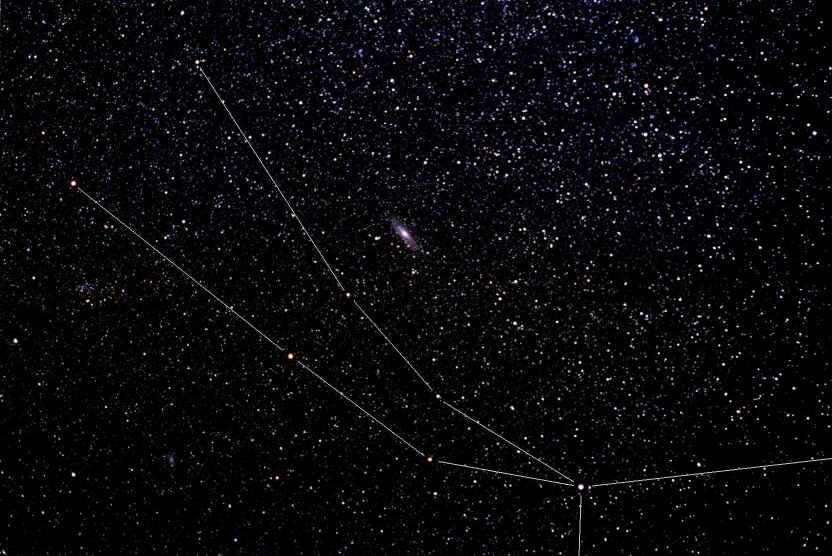
When I asked ET where he was from, he pointed to Andromeda. I assumed he came from the Great Andromeda Galaxy, as shown in the following wide angle picture.

The constellation lines are human inventions, of course, but ET's finger seemed to point to that faint galaxy in the middle of this image.
To be sure that's where ET came from, we went to my telescope and took a time exposure, shown below.
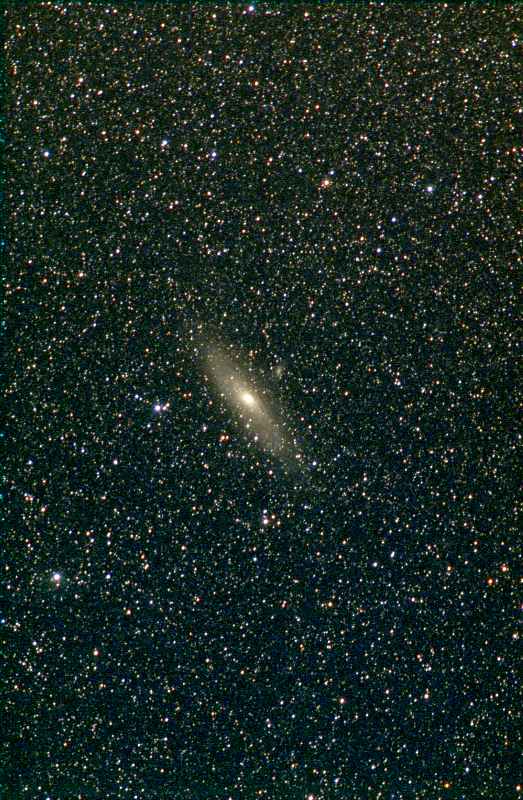
Again, ET pointed to the galaxy. But his stubby finger was actually pointed slightly to the left of the galaxy center.
So I took another picture, zooming in even closer to the Andromeda Galaxy.
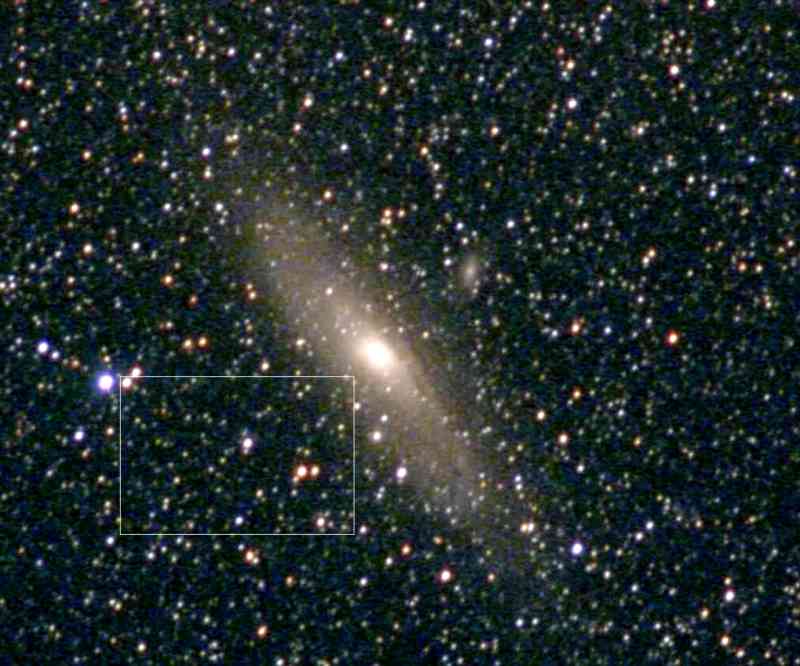
ET pointed to a region to the lower-left of the galaxy center, so I began to wonder if he was losing his memory. To humor him I took an even closer picture, centered on where he pointed. It wasn't the brightest star to the left, the blue one, and not the second brightest one, the reddish one, but one in between (mag 7.6), near the top of the little square that I drew for ET. (Be prepared for the stars to be "smaller" - which is due to the use of a telescope with better resolving power. Ignore the boundaries of the square; it merely includes the area of interest.)
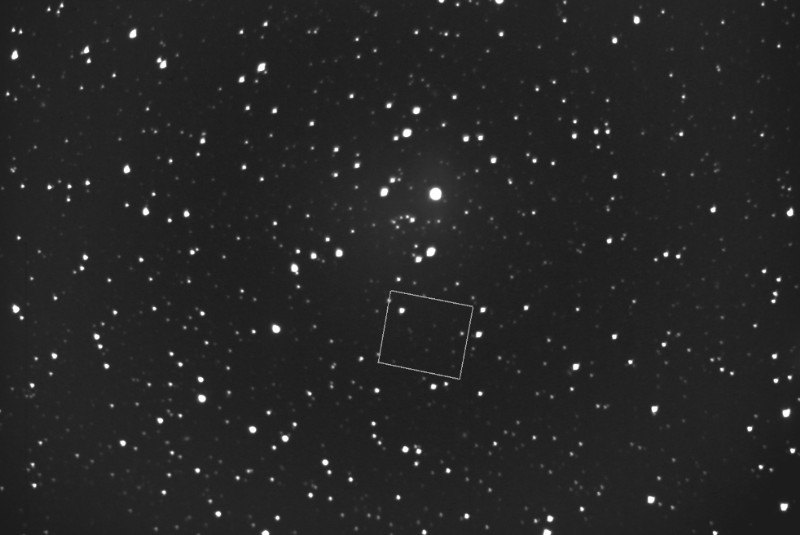
With this picture ET said "yes" and pointed to the center - but he needed to "get closer" and "go deeper" to see more stars. [Meade RCX400 14-inch, 34 x 23 'arc FOV, 28-minute total exposure, unfiltered; FWHM = 5.7 "arc; 2006.09.28]
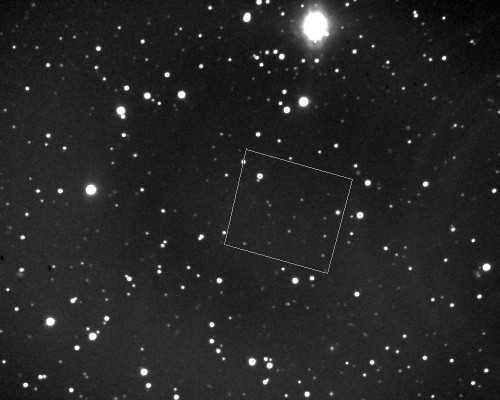
"Good" exclaimed ET. "More stars! Need more stars!" as ET pointed to the middle of this picture. So I made a thin square again, cropped it, and made a zoom so his stubby little finger could be more specific. [FOV = 16.3 x 12.9 'arc. 2003.09.16, CLR., 46 min.]
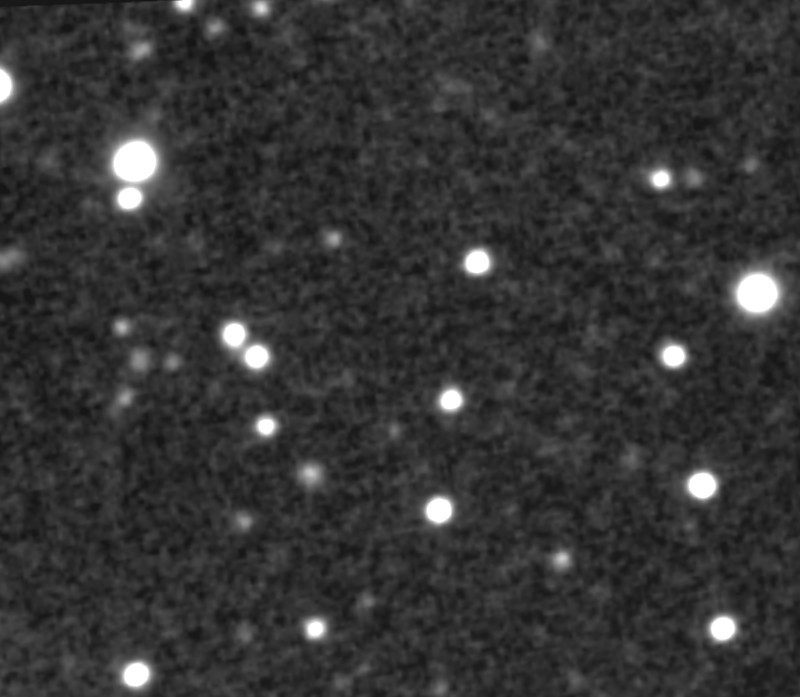
"Right there" said ET, pointing to a blank area near the center. [FOV = 3.48 x 3.09 'arc, FWHM = 4.0 "arc, faintest stars have mag ~ 21.5 (limiting magnitude =22.0 for SNR = 3), Celestron CGE-1400, SBIG AO-7 tip/tilt image stabilizer, SBIG ST-8XE CCD, 75-minute total exposure, clear filter; 2005.09.30, Hereford, AZ.]
Fortunately, the Hubble Space Telescope, with its Advanced Camera for Surveys (HST/ACS) has made a 3.5-day exposure of this area. So I downloaded the HST image and adjusted it to be at the same orientation and size as mine.
Here's mine and the HST's image of the same area. ET smiled (I
think) and said it was the galaxy below the center of the HST
image.
He pointed to the bright galaxy to the lower-left of center. I
could
see this galaxy in my image as well, so I felt proud to have taken a
picture
of ET's home. [The center of this image is at 00:46:07, +40:42:30]
But the HST original image has higher resolution, so I need to zoom in some more on the HST picture.
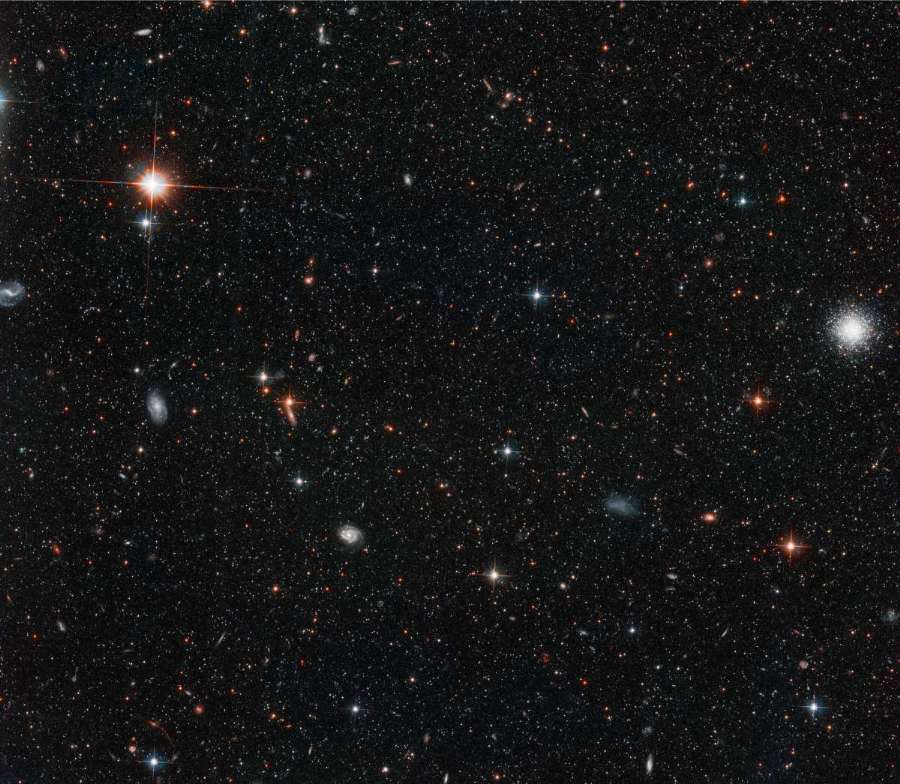
"Yes" ET exclaimed! And pointed to the galaxy to the lower-left of center. (Note: This isn't a full-resolution version of the HST image; it is vastly compressed to fit on the screen.)
Let's zoom in some more, because the HST original has even better resolution.
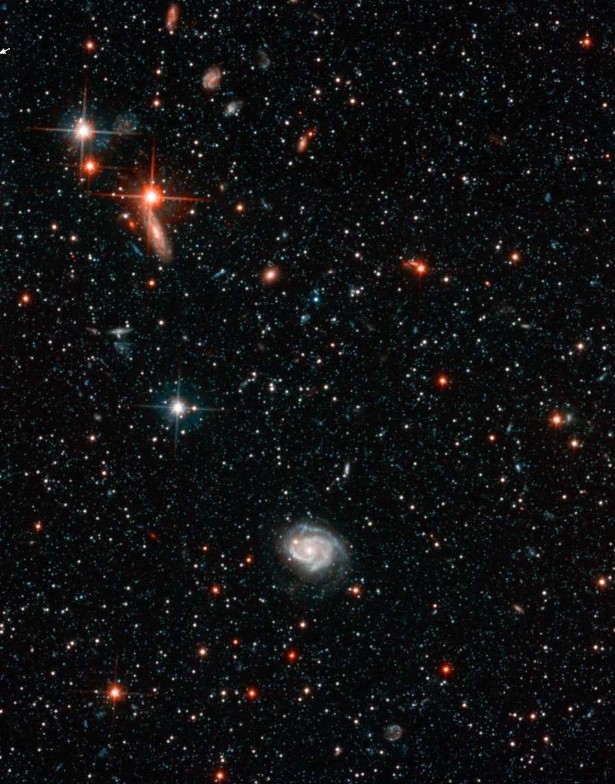
"Here's the galaxy" I said, but ET pointed above it. [55 x 65 "arc FOV]
More resolution is needed.
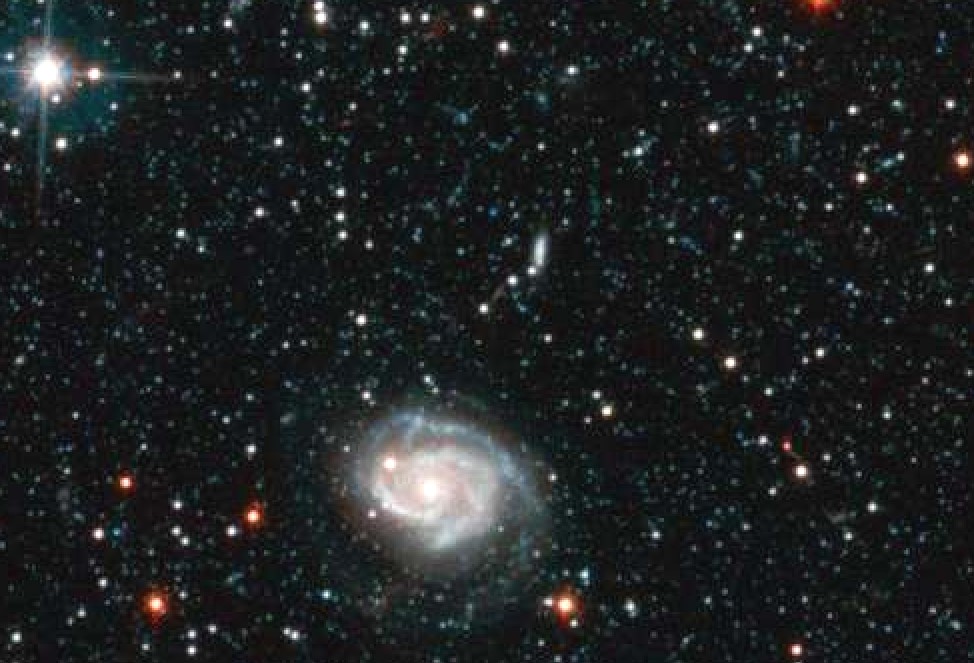
"There" exclaimed ET, as he pointed to the smudge above the galaxy I was looking at. [29 x 18 "arc]
Just to be sure, let's crop and zoom again.
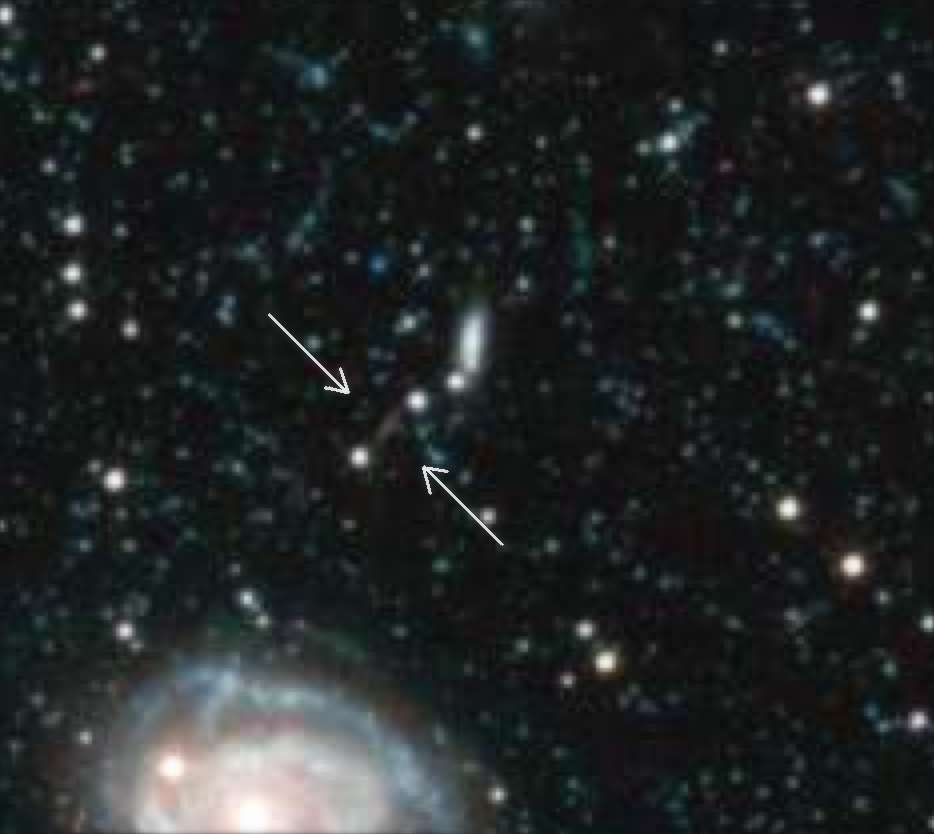
I was wrong again, for ET made sure I noticed this barely discernible, reddish galaxy, at magnitude 30, indicated by the arrows. [14.5 x 8.6 "arc; faintest stars are mag 30.7.]
ET wanted me to zoom in to the lower-left edge of the galaxy, but there was no more resolution to be had in the HST image. I think he meant where the arrow is pointing, in the next picture...
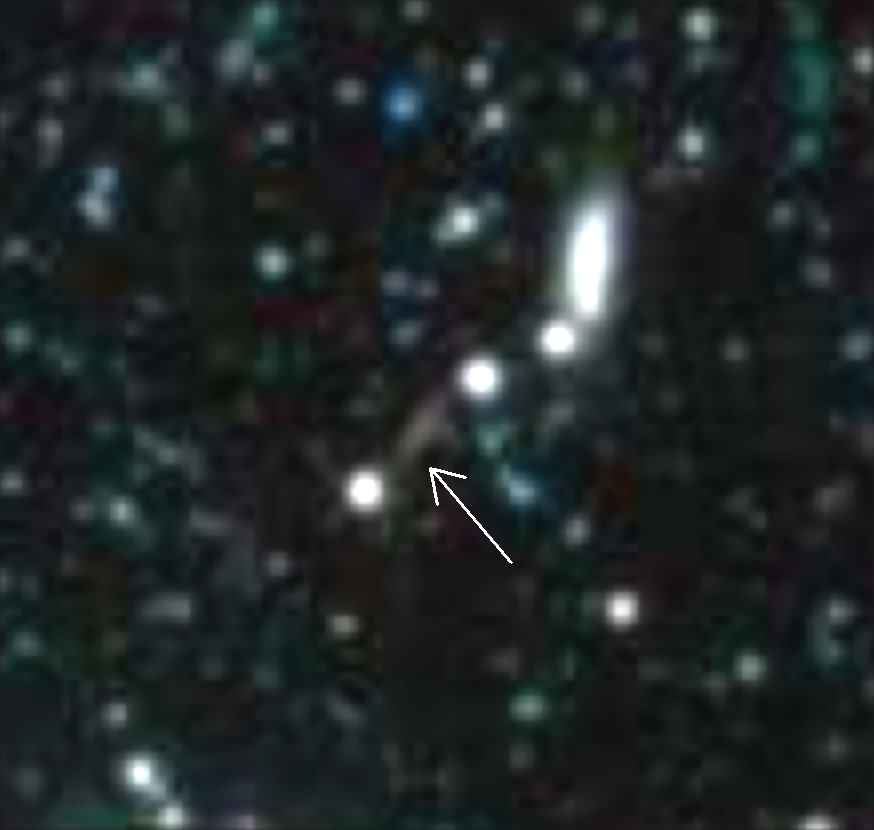
but before I could show him this crop and zoom he was gone! Going home, no doubt, home-sick for this one, most-special galaxy in the universe. [6.7 x 5.8 "arc; star images have width of 0.24 "arc]
__________________ Technical Comments ______________________________
Comparing images from a 14-inch amateur telescope with the Hubble Space Telescope is a ludicrous idea. But I like ludicrous ideas, so I did it.
Nevertheless, there are interesting things to learn from the comparison. It is instructive to consider the effects on limiting magnitude of the many differences between the two telescopes (and their location). In effect, this exercise will attempt to "reconcile" the difference in limiting magnitude between the HST's deep image and my amateur attempt at a deep image. I will consider the following five differences: 1) exposure time, 2) aperture, 3) smallness of star image (FWHM), 4) atmospheric absorption, and 5) filter widths.
1) First, consider exposure times. The faintest object discernible, or the limiting magnitude (SNR = 3 definition), varies with exposure time, E, according to: MagLim = 20.2 + 1.7 * LOG10(Exposure[min]). This empirical relation for my 14-inch Celestron, unfiltered, means that a 1-minute exposure shows 20.2 magnitude stars, a 4-minute exposure shows 21.2 magnitude, and every quadrupling of exposure time yields another magnitude. (This empirical relation differs slightly from he theoretical relation, which calls for a full magnitude increase for every 6.3-fold increase in exposure time, not every 4-fold increase, and I think this is due to the inclusion of "read-out noise" for each downloaded image; i.e., 10 1-minute exposures will be noisier than one 10-minute exposure.) So, if I had accumulated 3.5 days worth of images instead of my meager 69 minutes I could expect to achieve a limiting magnitude increase of 3.1 magnitudes (i.e., MagLim = 25.9).
2) Then there's a difference in aperture. The HST has an
aperture of 94 inches, which means it intercepts 45 times as many
photons
as my 14-inch intercepts (actually, it intercepts more when you
consider
atmospheric absorption). The HST therefore has a 4.1 magnitude
advantage
over a 14-inch telescope (all other things being equal). In other
words, if I upgraded to a 94-inch telescope my limiting magnitude
for a 3.5-day exposure would be 4.1 magnitudes fainter (i.e., MagLim =
30.0).
3) My "atmospheric seeing" limits me to FWHM ~3.5 "arc (using SBIG's AO-7 tip/tilt image stabilizer for 3-minute exposures). Typically, FWHM varies from 3.0 to 4.5 "arc (for 3-minute exposures). When I made the 75-minute total exposure (above) my seeing was 3.8 "arc. The HST, in contrast, has a resolution of about 0.24 "arc (after a 3.5-day total exposure). Theoretically, SNR degrades with FWHM according to the following equation: SNR ~ 1/FWHM. In other words, SNR varies was the reciprocal of FWHM (for faint objects). This is because with better seeing (smaller FWHM) the photometry signal aperture circle can be smaller, and since it will include fewer pixels, the thermal (stochastic) noise from the smaller number of pixels will be smaller (and proportional to the square-root of the number of pixels in the signal circle). For every halving of FWHM there's a corresponding gain in limiting magnitude of 0.75. The ratio of my FWHM to that for the HST was 16 (for this particular observation). Therefore, my SNR was 16 times smaller than the hypothetical case of my achieving HST's resolution, which translates to 3.0 magnitudes. So, if my hypothetical 94-inch telescope took a 3.5-day exposure with 0.24 "arc FWHM resolution I could expect to achieve MagLim = 32.2.
4) Atmospheric absorption exists for me, but not for HST. Across my unfiltered passband the zenith absorption produces a transmission of 70 to 90% (400 to 900 nm). My air mass varied from 1.7 to 1.1, averaging 1.4. For this air mass my average bandpass-weighted transmission is estiamted to be 75%. The loss of 25% of photons due to atmospheric absorption corresponds to a magnitude difference of 0.3. So, if my hypothetical 94-inch telescope took a 3.5-day exposure with 0.24 "arc FWHM resolution outside the atmopshere I could expect to achieve MagLim = 32.5.
5) My observation was unfiltered. The HST's consisted of
two filters (I think they were "visible" and "infrared"). I will
assume that each filter had a passband of ~30% of an unfiltered
passband. Combining the two images to produce a (false) color image
should
produce
a limiting magnitude equivalent to a single image with a 60%
passband. This represents a 0.6 magntidue loss compared with observing
unfiltered. So, if my hypothetical 94-inch telescope took a 3.5-day
exposure with
0.24 "arc FWHM resolution outside the atmosphere with the same
filtering used by the HST/ACT camera I could expect to achieve MagLim =
31.9.
Here's a summary of my equation for limiting magnitude, MagLim:
MagLim = 19.5 +5 * LOG(Aperture/14 inches) +1.7 *
LOG(Exp[min]} -2.5 * LOG(FWHM/2.6),
which ignores atmospheric absorption and CCD
temperature.
Since the HST result is reported as showing stars as faint as Mag =
30.7. Since the faintest stars have SNR ~ 6, I infer that the
HST/ACS had MagLim of 31.2. My predicted MagLim using an HST/ACS system
differs
from this by 0.7 magnitudes.
I suspect this discrepancy of 0.7 magnitudes can be accounted for by my use of an over-simplified equation for SNR versus FWHM when the faint star is embedded in a backgound of star and galactic emission, called "sky background." For the amateur this is not an issue, since the faintest objects are bright compared with this sky background (for dark sites). I've also used a value for the HST's FWHM is 0.24 "arc which I derived from an image I downloaded, and my FWHM measure varied with brightness and star color. I also assumed similar quantum efficiency and system efficiency for registering photons, and their system efficiency may be lower for the ACS. Their stated faintest star might have been based on SNR values anywhere within the range 3 to 10, since there appears to be no standard when statng limiting magnitude. In view of these many uncertainties for comparing my amateur system with the Hubble Space Telescope, it is surprising to me that the two limiting magnitudes are as compatible as they are, being discrepant by only 0.7 mangitudes. This should give amateurs confidence that they can plan "deep" projects with predictable results.
Incidentally, if you want to see portions of the full-resolution version of the HST/ACS image, click here.
Image Credits: All HST/ACS images were produced by NASA (National Aeronautics and Space Administration) and STScI (Space Telescope Science Institute).
This site opened: September 16, 2003. Last Update: September 28, 2006